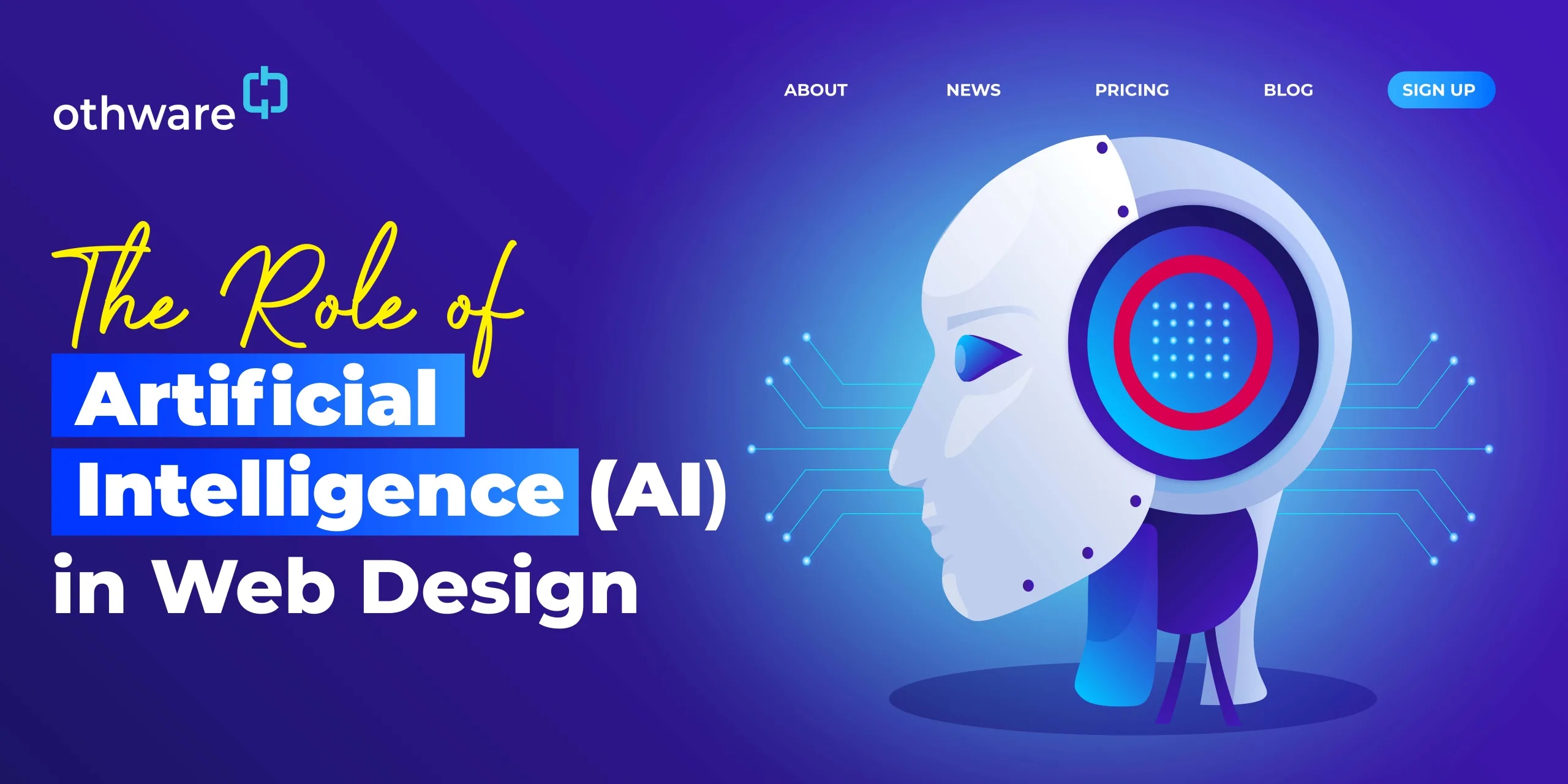
The Role of Artificial Intelligence (AI) in Web Design
The Evolution of Web Design and the Emergence of AI
Web design has come a long way since the early days of the Internet. Initially, websites were simple and static, primarily focusing on displaying information rather than engaging users. However, with technological advancement and the ever-increasing expectations of users, web design has evolved into a multidimensional discipline emphasizing aesthetics, usability, and user experience. So what has been the role of AI in web design?
The emergence of artificial intelligence (AI) has influenced a paradigm shift in web design. AI is a machine’s ability to simulate human intelligence and perform tasks that traditionally require human intervention. This technology has enabled web designers and developers to create websites that are visually appealing, intelligent, and interactive.
AI has revolutionized web design by introducing automation, personalization, and data-driven decision-making. It has empowered designers to go beyond static layouts and create dynamic, user-centric experiences. By leveraging AI algorithms and machine learning, web designers can understand user behavior, predict user preferences, and tailor websites accordingly. The role of AI in web design can therefore not be downplayed.
The following sections will explore how AI plays a crucial role in modern web design, contributing to enhanced user experiences and higher conversion rates. We will delve into specific applications of AI, such as personalization, automation, user research, optimization, and more. So, let’s embark on this exciting journey to discover the immense role of AI in shaping the future of web design.
Definitions and Key Concepts Associated with AI in Web Design
Before delving into the role of AI in web design, it’s essential to understand the fundamental concepts and definitions associated with this technology. AI, in the context of web design, refers to using intelligent algorithms and machine learning techniques to automate tasks, analyze data, and enhance user experiences.
Machine Learning
Machine learning, a subset of AI, forms the backbone of intelligent websites. It involves developing algorithms that can recognize patterns, make predictions, and adapt based on feedback. Machine learning algorithms can uncover insights and improve website performance by analyzing large volumes of data.
Natural Language Processing (NLP)
Natural Language Processing (NLP) is a branch of AI that enables machines to understand and generate human language. For example, in web design, NLP creates chatbots and voice interfaces that provide personalized and interactive experiences. These interfaces can understand user queries, respond intelligently, and guide users through websites or assist with customer support.
Computer Vision
Computer vision is another AI technique that allows machines to interpret and analyze visual content. For example, in web design, computer vision algorithms enable tasks such as image recognition, object detection, and augmented reality. This technology enhances visual experiences by making websites more engaging, interactive, and visually appealing.
Recommendation Systems
Recommendation systems powered by AI play a crucial role in personalizing user experiences. By analyzing user behavior, preferences, and historical data, these systems suggest relevant content or products to individual users. By tailoring recommendations, web designers can improve engagement, increase conversions, and foster customer loyalty.
Predictive Analytics
Fueled by AI, predictive analytics empowers web designers to make data-driven decisions. By analyzing large datasets, predictive analytics algorithms can identify trends, predict user behavior, and forecast market trends. This information allows designers to optimize website design, content, and marketing strategies to maximize conversions and stay ahead of the competition.
By incorporating these AI concepts into web design, designers can create intelligent websites that adapt to users’ needs, provide personalized experiences, and optimize performance. The following sections will explore specific applications of AI in web design and highlight the benefits they bring to user experience and conversion rates.
Significant contributions of AI to the world of web design
AI has revolutionized the design field, empowering web designers to create intelligent and interactive websites beyond static layouts. From personalization and automation to user research and optimization, AI enhances user experiences and drives higher conversion rates.
Personalization (AI-driven User Experience)
One of the critical contributions of AI to web design is the ability to deliver personalized user experiences. Personalization involves tailoring website content, recommendations, and interactions to individual users based on their preferences, behavior, and demographic information. AI algorithms are crucial in analyzing vast amounts of user data and generating personalized experiences that resonate with each user.
Below is how AI is being used to better user experience through personalization.
Dynamic Content Generation
AI enables web designers to dynamically generate content based on user preferences and behavior. By analyzing user data like browsing history, past interactions, and demographic information, AI algorithms can automatically present relevant and engaging content to each user. For example, it could include personalized product recommendations, targeted offers, or customized landing pages.
Personalized Search and Navigation
AI-powered search and navigation systems enhance user discovery on websites. These systems leverage machine learning algorithms to understand user search queries, interpret intent, and provide accurate and personalized search results. By analyzing user behavior and preferences, AI can also suggest relevant filters, categories, or navigation paths, making it easier for users to find what they are looking for.
Tailored Content Recommendations
AI-based recommendation systems analyze user data to generate personalized content recommendations. You can display these recommendations in various website sections, such as product suggestions, related articles, or recommended videos. By tailoring content to individual user interests and preferences, web designers can increase user engagement and time on-site and drive conversions.
Retargeting and Behavioral Triggers
AI allows web designers to implement retargeting strategies and behavioral triggers encouraging return visits and engagement. By analyzing user behavior, AI algorithms can identify users interested in specific products or content and retarget them with personalized messages or offers. It increases the chances of converting users who have previously interacted with the website.
Streamlining Design Processes
AI brings automation to web design by streamlining repetitive tasks, saving time, and enabling designers to focus on more creative and strategic scopes of their work. By automating specific design processes, AI empowers designers to work more efficiently and effectively.
Here’s how AI is streamlining web design processes.
Automated Layout Generation
AI algorithms can automatically generate website layouts based on predefined design principles, user preferences, or design templates. This automation expedites prototyping, allowing designers to explore different design options and iterate on their ideas quickly. By automating layout generation, designers can save time and effort while maintaining control over the final design.
Content Generation
AI can assist in generating content for websites, such as writing product descriptions, blog posts, or social media captions. Natural Language Processing (NLP) techniques enable AI algorithms to understand and generate human-like text. Additionally, AI can help select or create images that align with the website’s theme or target audience. This automation reduces the burden of content creation and ensures consistency across the website.
Automated Testing and Quality Assurance
AI-powered testing tools can automate detecting and fixing bugs, checking website compatibility across different devices and browsers, and optimizing website performance. In addition, these tools can simulate user interactions, identify potential issues, and provide recommendations for improvement. As a result, automated testing reduces the time and effort required for manual testing, ensuring a smoother user experience and better overall website quality.
Optimizing Conversion Rates
Conversion rate optimization (CRO) is a crucial goal for web designers and businesses, aiming to maximize the percentage of website visitors who take desired actions, such as purchasing, subscribing to a newsletter, or filling out a form.
As shown below, AI plays a significant role in UX design and A/B testing, helping designers optimize websites for improved conversion rates.
Identifying Conversion Bottlenecks
AI algorithms can analyze website user journeys, track user interactions, and identify potential conversion bottlenecks. By understanding where users drop off or encounter obstacles in their journey, designers can make targeted improvements to the user flow, minimize friction points, and increase the likelihood of conversions.
Personalized Calls-to-Action (CTAs)
AI enables the customization of calls-to-action (CTAs) based on user profiles, behavior, and preferences. By analyzing user data and segmenting users into different groups, designers can deliver personalized CTAs more likely to resonate with specific user segments. This personalization increases the effectiveness of CTAs and drives higher conversion rates.
AI-powered A/B Testing
A/B testing is a common practice in web design, comparing two or more variations of a webpage to determine which performs better in conversions. AI can facilitate A/B testing by automating creating variations, tracking user interactions, and analyzing results. AI algorithms can quickly identify the most effective design elements or content variations, allowing designers to iterate and optimize for higher conversion rates.
Predictive Analytics for Conversion Optimization
Powered by AI, predictive analytics can forecast user behavior and predict the likelihood of conversions. By analyzing historical data and user patterns, predictive analytics algorithms can identify factors contributing to conversions and provide insights on optimizing websites for improved conversion rates. This data-driven approach enables designers to make informed decisions and implement strategies that are more likely to drive conversions.
AI-powered Chatbots
AI-powered chatbots have revolutionized customer engagement and support in web design. These intelligent virtual assistants use natural language processing and machine learning algorithms to understand and respond to user queries, providing instant assistance and improving overall customer experience.
Read also: The Best Web Designing Companies in Uganda
Below are examples of how AI-powered chatbots are revolutionalizing web design
Automated Customer Support
AI-powered chatbots are available round the clock, responding instantly to customer queries and concerns. They can handle various customer support tasks, such as answering frequently asked questions, providing order status updates, or troubleshooting common issues. In addition, with their ability to quickly analyze and process vast amounts of data, chatbots can offer prompt and accurate support, enhancing customer satisfaction and loyalty.
Personalized Interactions
AI chatbots can personalize interactions based on customer data and previous interactions. Chatbots can deliver personalized recommendations, relevant offers, and customized responses by analyzing user profiles, purchase histories, and preferences. This level of personalization creates a more engaging and tailored experience for customers, leading to increased satisfaction and a higher likelihood of conversions.
Natural Language Understanding
AI chatbots utilize natural language processing (NLP) techniques to understand and respond to user queries conversationally. They can interpret user intent, handle complex inquiries, and provide human-like conversations. As a result, chatbots create a more intuitive and user-friendly support experience by simulating natural human interactions, making customers feel heard and understood.
Multichannel Support
You can integrate AI chatbots into various platforms and channels, including websites, social media platforms, and messaging applications. This multichannel support enables customers to interact with the chatbot through their preferred communication channel. So whether it’s a website chat window, Facebook Messenger, or WhatsApp, chatbots provide consistent and seamless support across platforms, ensuring customers can reach out for assistance wherever they are.
Continuous Learning and Improvement
AI chatbots learn and improve continuously over time by design. Through machine learning algorithms, chatbots analyze customer interactions, gather feedback, and adapt their responses to provide more accurate and helpful assistance. This iterative learning process allows chatbots to become more knowledgeable and efficient, resulting in improved customer support and higher customer satisfaction rates.
Enhancing Visual Appeal (AI-powered Design Elements and Graphics)
In addition to its role in automation and user research, AI also contributes to improving the visual appeal of websites through the generation of design elements and graphics. AI-powered tools and algorithms provide designers innovative ways to create visually stunning and engaging web interfaces.
Generative Design
Generative design, a technique that utilizes AI algorithms, enables the creation of unique and creative design assets. By defining parameters and constraints, designers can automatically generate various design variations. AI algorithms analyze patterns, aesthetics, and user preferences to produce visually appealing and original elements, such as backgrounds, icons, or illustrations.
Responsive Design Optimization
AI-powered responsive design optimization allows visual elements to adapt and adjust based on the device and screen size. AI algorithms can dynamically change the layout, typography, and images by analyzing device characteristics and user behavior to ensure optimal visual presentation across different devices. This optimization ensures the website maintains its visual appeal and usability on various screens.
Dynamic and Interactive Visual Effects
AI-powered tools can generate dynamic and interactive visual effects that engage users and create immersive experiences. From particle animations to parallax scrolling, these effects bring websites to life, capturing users’ attention and enhancing their overall engagement. AI algorithms analyze user interactions and adjust visual effects in real-time, creating personalized and captivating experiences.
By leveraging AI-powered design elements and graphics, web designers can enhance the visual appeal of websites, creating stunning and captivating interfaces. These AI-driven tools provide designers with innovative ways to express their creativity, deliver visually impactful designs, and engage users on a deeper level.
Conclusion
The role of AI in web design is undeniably crucial, revolutionizing how to create, optimize, and tailor websites to meet the evolving needs of users. From personalized user experiences to streamlined design processes, AI empowers web designers to enhance user engagement, drive conversions, and deliver exceptional user experiences.
When navigating the dynamic landscape of digital marketing, partnering with a reliable and experienced agency is essential. At Othware Uganda, we combine our expertise in AI-powered web design with a deep understanding of the digital landscape. So trust Othware Uganda as your digital marketing partner to leverage the transformative potential of AI in web design and propel your business toward success in the digital realm.

Passionate about tech, a better writer than talker. Also a Content writer @ Othware.



